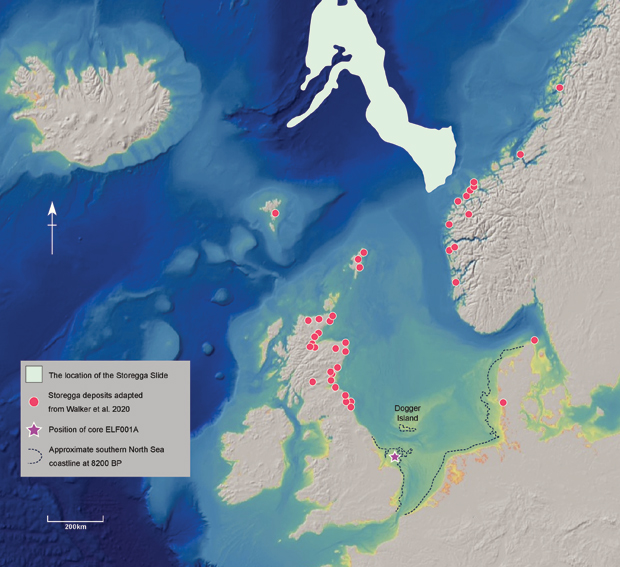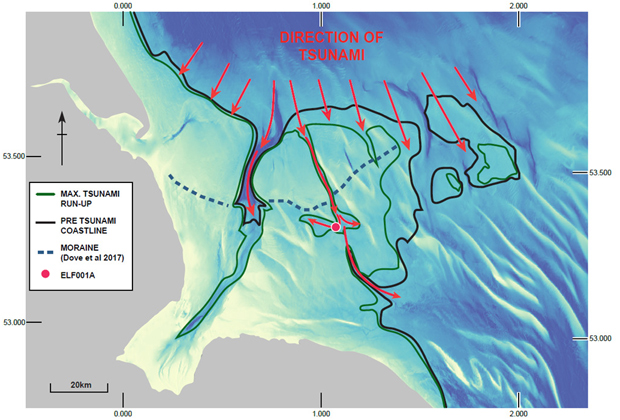Massive Tsunamis Devastated Ancient Britain
Scientists led by the University of Bradford have made a major breakthrough in the hunt for confirmation of a historic mega tsunami that is thought to have raged across the North Sea some 8,150 years ago. Evidence of the catastrophic event has already been found in onshore sediments in Western Scandinavia, the Faroe Isles, north-eastern Britain, Greenland and Denmark but now for the first time, confirmation of the event has been identified on the UK’s southern coasts.
Map Showing the Location of the Storegga Slide
Picture credit: University of Bradford
Doggerland and the Storegga Slide
The giant tsunami, known as the Storegga Slide, was caused when an area of seabed the size of Scotland (measuring some 80,000 square kilometres and around 3,200 cubic kilometres), shifted suddenly off the coast of Norway. This triggered huge waves that would have brought devastation to an inhabited ancient land bridge, which once existed between ancient Britain and mainland Europe, a region known as Doggerland, that is now submerged beneath the North Sea.
Professor Vince Gaffney (University of Bradford) explained:
“Exploring Doggerland, the lost landscape underneath the North Sea, is one of the last great archaeological challenges in Europe. This work demonstrates that an interdisciplinary team of archaeologists and scientists can bring this landscape back to life and even throw new light on one of prehistory’s great natural disasters, the Storegga Tsunami”.
The professor from the University’s School of Archaeological and Forensic Sciences in the Faculty of Life Sciences went onto add:
“The events leading up to the Storegga tsunami have many similarities to those of today. Climate is changing and this impacts on many aspects of society, especially in coastal locations.”
Finding Traces of the Natural Disaster in the Southern North Sea
It is thought the tsunami, the largest to hit Northern Europe since the end of the last ice age, happened following a period of global climate change. Until now no clear trace of the tsunami had been found across the southern North Sea and importantly no trace had been found on Doggerland, which was gradually swallowed by rising sea levels after the end of the last glacial maximum. Indeed, scientists now think the tsunami may even have led to the final inundation of Doggerland.
Cores from an area south of a marine trough named the Outer Dowsing Deep provided nearly half a metre of tsunami-like deposits, stones and broken shells sandwiched between laminated estuarine sediments. Dating indicated they were contemporary with the Storegga event, while analysis including geochemical, sedimentological, palaeomagnetic, isotopic, palaeobotany and “sedaDNA” (sedentary DNA), techniques showed the deposits could be readily interpreted as resulting from a tsunami.
Area of Ancient Tsunami Research off the Norfolk Coast
Picture credit: University of Bradford
The study was led by the University of Bradford and collaborators from the University of Warwick, St Andrews University and a number of other academic institutions including the Washington Smithsonian and the London Natural History Museum.
Differentiating a Tsunami Event from Periodic Storm Activity
Evidence for a tsunami event is often difficult to discern from sediment deposition that results from periodic storm activity. Key to understanding the sequence of events was the interpretation of geochemical signatures of three major waves hitting and retreating from the land. In a part of the research instigated by the University of Warwick team, the scientists were able to examine how biomass changes with large natural events.
Professor Robin Allaby (University of Warwick) stated:
“This study represents an exciting milestone for sedimentary ancient DNA studies establishing a number of breakthrough methods to reconstruct an 8,150 year old environmental catastrophe in the lands that existed before the North Sea flooded them away into history.”
At the time the tsunami hit Doggerland, a Mesolithic hunter-gather people could have been using the remaining archipelago and for those unfortunate enough to be caught within the tsunami runup zone, it would have been devastating. However, the palaeo-topography and environmental modelling suggest that much of the landscape may have survived reasonably intact to rapidly return to pre-tsunami conditions. The longer term fate of these lands was to be submerged as sea level rose to those of the present day.
Professor Vince Gaffney (University of Bradford)

Picture credit: University of Bradford
Everything Dinosaur acknowledges the assistance of a media release from the University of Bradford in the compilation of this article.
The scientific paper: “Multi-Proxy Characterisation of the Storegga Tsunami and Its Impact on the Early Holocene Landscapes of the Southern North Sea” by Vincent Gaffney, Simon Fitch, Martin Bates, Roselyn L. Ware, Tim Kinnaird, Benjamin Gearey, Tom Hill, Richard Telford, Cathy Batt, Ben Stern, John Whittaker, Sarah Davies, Mohammed Ben Sharada, Rosie Everett, Rebecca Cribdon, Logan Kistler, Sam Harris, Kevin Kearney, James Walker, Merle Muru, Derek Hamilton, Matthew Law, Alex Finlay, Richard Bates and Robin G. Allaby and published in the journal Geosciences.
The Everything Dinosaur website: Everything Dinosaur.








Leave A Comment